Sergei Vasiliev
Sergei Vasiliev was born in 1936 in the Chuvash region of Russia. He was a staff photographer for the newspaper Vecherny Chelyabinsk for over thirty years. He has received many honours including International Master of Press Photography from the International Organization of Photo Journalists (Prague, 1985), Honoured Worker of Arts of Russia, and the Golden Eye Prize. His work has been exhibited internationally and is held in numerous museum collections. He is author of more than twenty books, including Russian Beauty (1996) and Zonen (1994). Sergei Vasiliev died in 2021.
His work has been exhibited internationally as part of the Russian Criminal Tattoo Exhibition. Thirteen large format Russian Criminal Tattoo prints were shown at the Saatchi Gallery in the exhibition Gaiety Is The Most Outstanding Feature Of The Soviet Union, 21 Nov 2012 – 9 June 2013.
Print No. 1
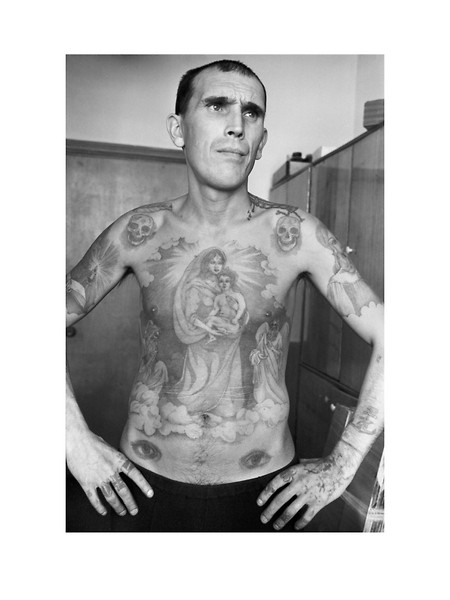
Mikhail Kovanev, poet, artist and musician, was serving a sentence of fifteen years for murder. He claimed he was innocent of this charge. Every part of his body was covered with tattoos, many of his own design. The eyes on the stomach mean that he was a homosexual (the penis makes the 'nose' of the face). In the colony he became a drug addict and was subsequently killed.
Scroll for more
Print No. 2
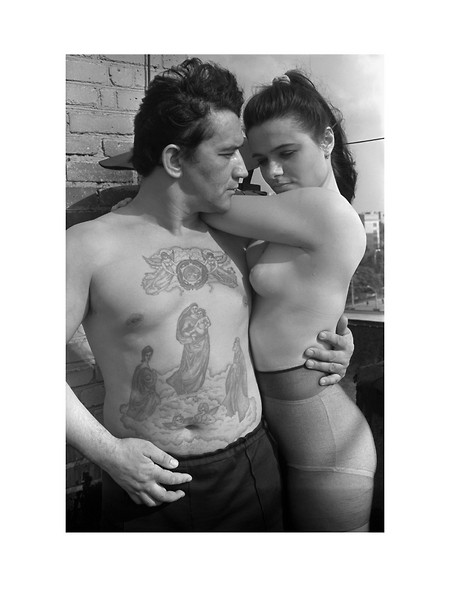
These tattoos are in the 'traditional' style: a large central tattoo covering the chest and stomach area. The central motif is based on Raphael’s Madonna from the Sistine Chapel. This was a popular thieves’ ‘talisman’, reserved only for the highest ranking areas of the body.
Scroll for more
Print No. 3
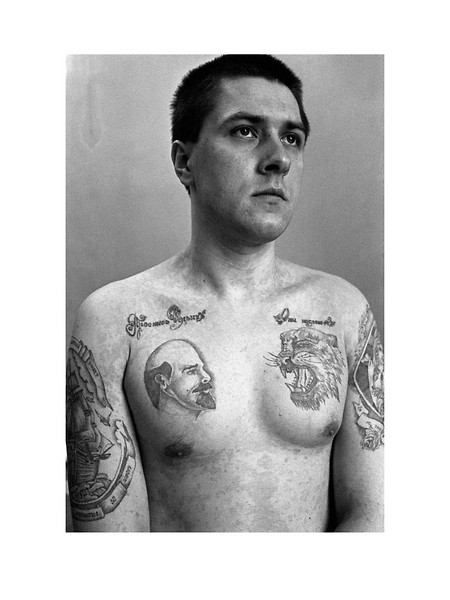
Traditionally tattoos bearing images of Lenin and Stalin were usually tattooed onto the chest, it was a commonly held belief that Communist firing squads were not permitted to shoot at an image of their leaders. Text above Lenin reads ‘Wake up Ilyich (Lenin)’, above the tiger ‘They (criminals) are getting brazen’.
Scroll for more
Print No. 4

The tattoo on the shoulder of a spider in a cobweb can carry different meanings: if the spider is climbing up the web then the bearer of the tattoo is fully committed to a life of crime, if it is climbing down the wearer is attempting to break free of their criminal lifestyle.
Scroll for more
Print No. 5
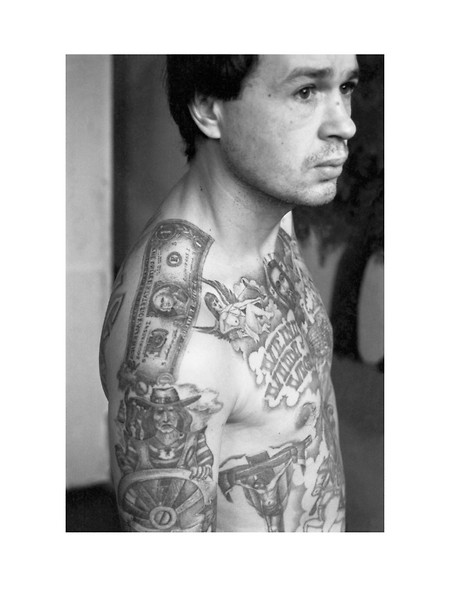
This convict’s tattoos were applied in the camps of the Urals where the tattoo artists produce work of exceptional quality. Because they were so held in such high regard, criminals often attempted to be transferred there in order to be tattooed. The dollar bill on the shoulder signifies the bearer’s commitment to a life of crime.
Scroll for more
Print No. 6
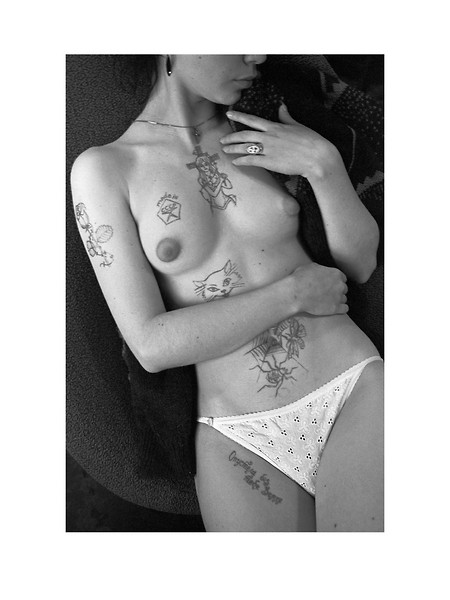
The text at the top of the thigh reads: 'The earth is empty without you'. The 'Made in CCCP' tattoo on the right breast is the state quality mark of the USSR. This symbol was only applied to consumer goods of the 'highest quality'. The rose tangled in barbed wire on the shoulder, denotes that the bearer celebrated their 16th or 18th birthday in the ‘zone’.
Scroll for more
Print No. 7
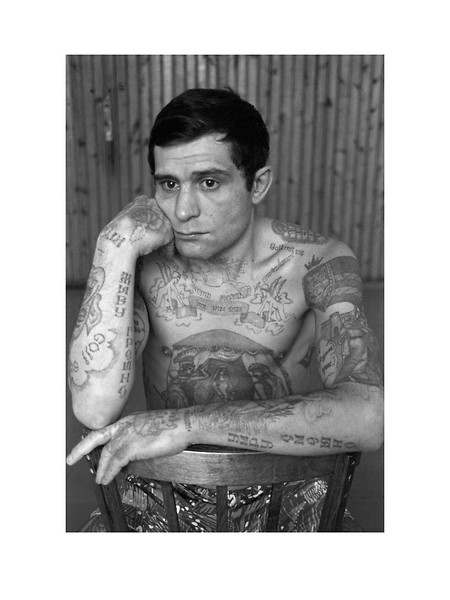
This convicts apparently random tattoos denote his rank within the criminal world. They embody a thief’s complete ‘service record’, his entire biography, detailing all of his achievements and failures, his promotions and demotions, his ‘secondments’ to jail and his ‘transfers’ to different types of ‘work’. A thief’s tattoos are his ‘passport’, ‘case file’, ‘awards record’, ‘diplomas’ and ‘epitaphs’. In this world a man with no tattoos has no social status whatsoever. Across the chest ‘Death is not vengeance / the dead don’t suffer’. On the arms ‘I live in sin / I die laughing’.
Scroll for more
Print No. 8
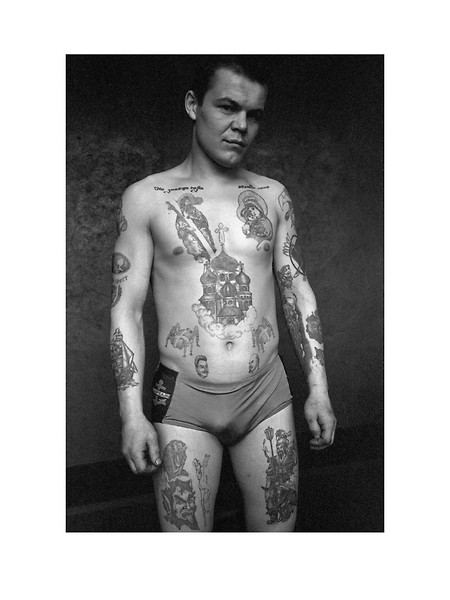
Orthodox religious tattoos are still among the most popular amoung criminals today. The crucifix and the Madonna and Child, depicted in the Orthodox tradition of icon painting, meant ‘my conscience is clean before my friends’, ‘I will not betray’. The Madonna signified ‘prison is my home’ – that the wearer was a multiple offender and recidivist. The number of domes on the tattoo of a church indicates the number of convictions. If a dome was adorned with a cross, it meant that the sentence had been served in full. As well as being a totem of a pickpocket, the scarab beetle is considered to bring luck to the wearer, these are usually tattooed on the hands, rarely (as in this image) they appear on other parts of the body.
Scroll for more
Print No. 9
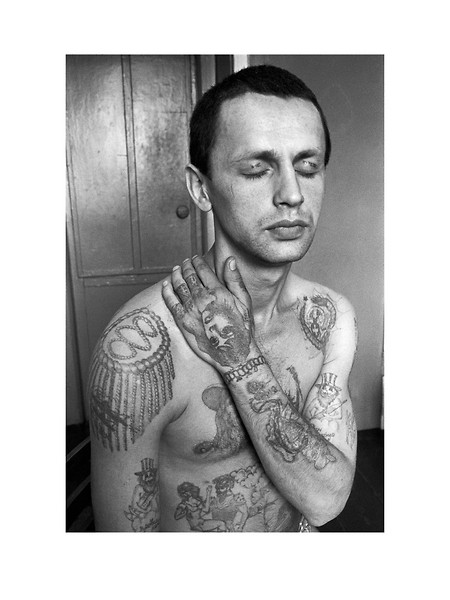
The tattoos across the eyelids read ‘Do not / Wake me’. The genie on the forearm is a common symbol of drug addiction. If an addict is imprisoned for drug offences, he or she will have to go through withdrawal in the ‘zone’ (prison). Epaulette tattoos (on the shoulders) display the criminal’s rank in a system that mirrors that of the army (major, colonel, general etc).
Scroll for more
Print No. 10
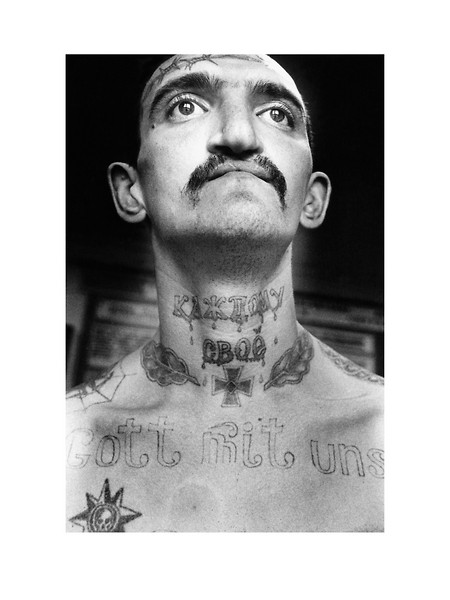
This inmate was convicted for drug related crimes. 'Gott mit uns': 'God with us' was a rallying cry of both the Russian empire and the Third Reich. The Nazi Iron Cross expresses ‘I don’t care about anybody’. This symbol of aggression and insubordination is often tattooed on the chest tattooed as if hung on a chain. The barbed wore on the forehead denotes that the bearer ‘will never be corrected’.
Scroll for more
Print No. 11
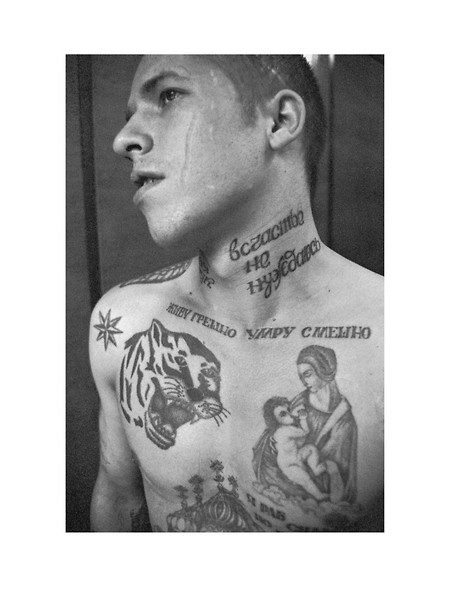
The tattoo on the neck reads 'I don't need happiness', beneath the neck 'I live in sin, I die laughing'. The scar on this criminals face is usually forcibly applied as a punishment to any convict who has informed or betrayed his fellow inmates.
Scroll for more
Print No. 12
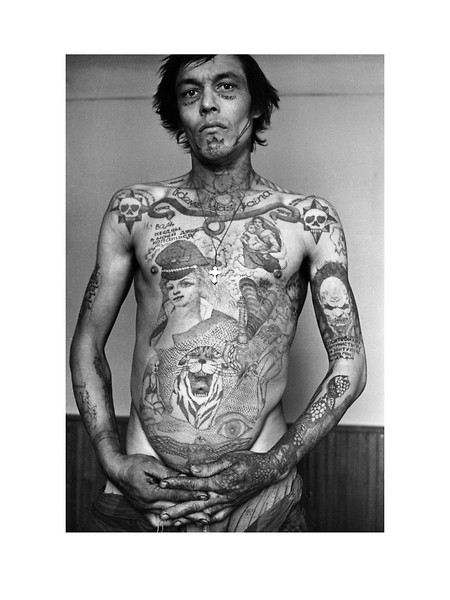
This prisoner’s tattoos display his anger and bitterness towards Communist power; the tattoos on the face signify that he never expects to go free. He works as a stoker. Text under the eyes reads ‘Full / of Love’; on the chin ‘Danger of Death’; around the neck ‘To each his own’; above each head of the double-headed snake ‘Wife’ and ‘Mother-in-law’; on the chest ‘It is not for you whores, to dig in my soul’; on his arm ‘Communists, suck my dick for my ruined youth’.
Scroll for more
Print No. 13
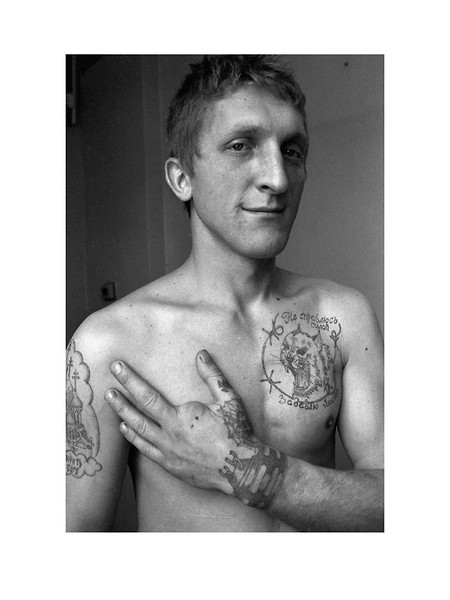
The tattoo on the chest is a 'grin' at the authorities, the text above and below reads ‘If I can’t crush them with my strength / I will crush them with my rage’. The number of barbs on the wire equal the number of years in the sentence. The manacles on this prisoners wrist signify a sentence of five years or longer.
Scroll for more
Print No. 14
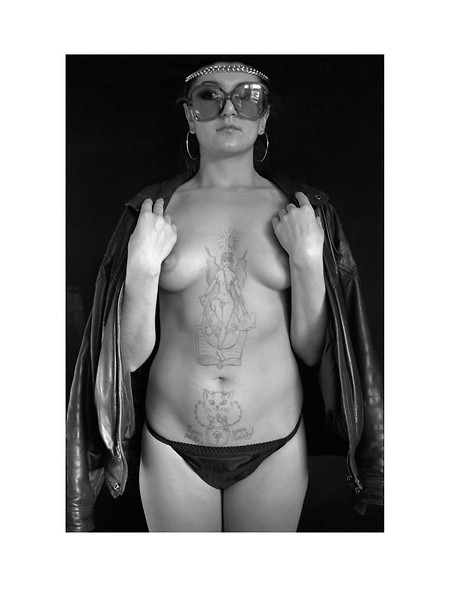
The text around the lock reads: 'Treasure love, appreciate freedom!' The symbol on the lock is the mark of soviet quality.
Scroll for more
Print No. 15
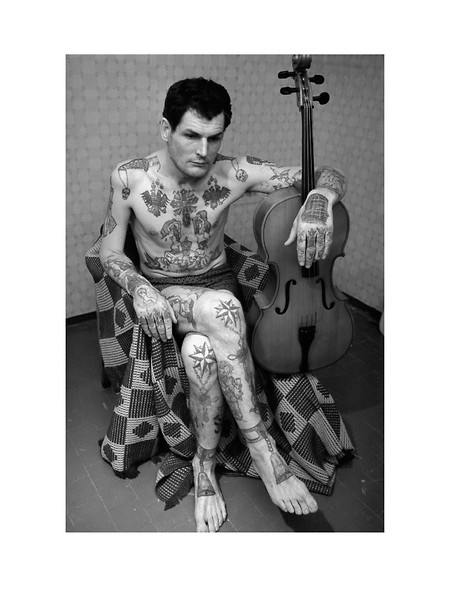
The dagger through the neck shows that the prisoner committed murder while in prison, and that he is available to 'hire' for further murders. The bells on the feet indicate that he served his time in full ('to the bell'), the manacles on the ankles mean that the sentences were over five years. 'Ring' tattoos on the fingers show the status of the criminal when the rest of his body is covered. The 'thieves' stars' on the knees carry the symbolic meaning ‘I will not kneel before the police'.
Scroll for more
Print No. 16
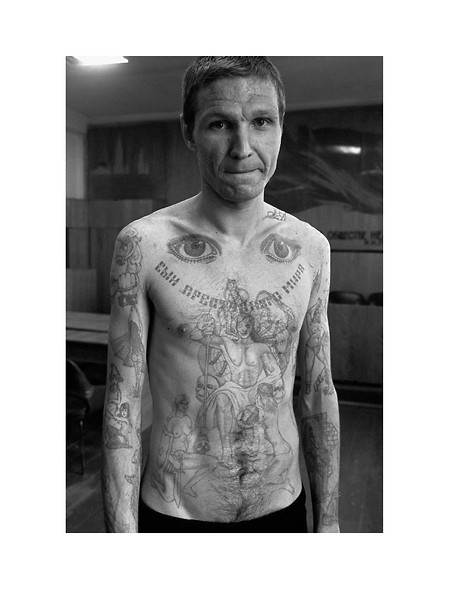
The eyes on the top of the chest signify 'I can see everything' and 'I am watching'. Text across the chest reads 'Son of the criminal world'. This photograph shows tattoos in a combination of old and new styles. In the ‘new’ style a large number of almost random images on the convict’s body. In the ‘traditional’ style there is one large central tattoo on the chest, filling as much space as possible.
Scroll for more
Print No. 17
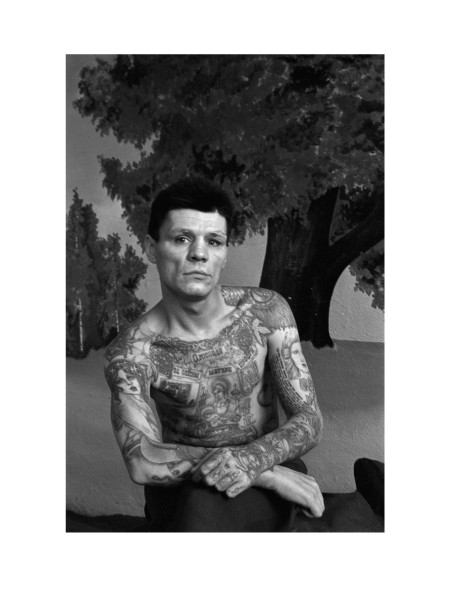
The epaulette and the spider on the shoulders denote a high-ranking criminal. The text across the chest reads: ‘O Lord, forgive me for the tears of my mother’. On the right side of the bearers chest is tattooed 100-ruble note, usually signifying involvement in counterfeiting and commitment to criminal life.
Scroll for more
Print No. 18
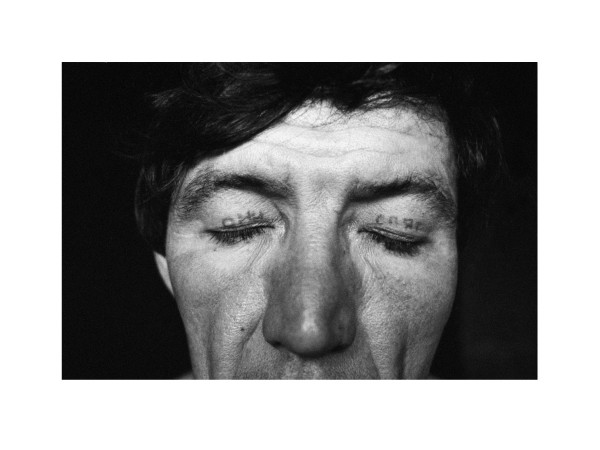
Tattoos on the eyelids are made by inserting a metal spoon under the lid so that the ‘needle’ doesn’t penetrate the eye. Here the text reads ‘They’re / Sleeping’. It is common for this type of tattoo to personify the part of the body on which they appear, for example tattoos across the feet might say ‘They’re tired / of walking’.
Scroll for more
Print No. 19
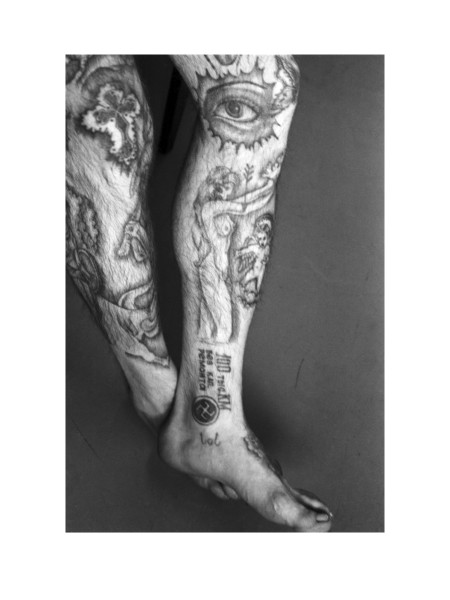
The text on the ankle reads ‘100 thousand kilometers without a major overhaul’ (referring to the distance walked by the prisoner). The eye signifies that the bearer is always on guard. The thieves cross tattooed on the knee means ‘I will not kneel before the police’.
Scroll for more
Print No. 20
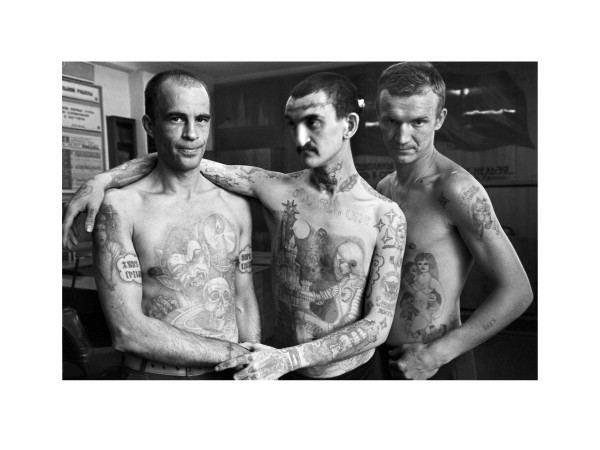
A group of convicts imprisoned for drug-related crimes. Convict (left) on both arms: ‘I live in sin / I die laughing’. Images of demons and monsters are intended to intimidate other inmates and give significance to the bearer within his circle. Convict (centre) German text below the neck: ‘God with us’; on the left arm: ‘Hurry up and live’. The sailing ship on the forearm signifies a lust for freedom and that the bearer is a potential escapee. Convict (right) on upper arm: ‘Keep love’; on forearm: ‘KRAB’: Klyanus Rezat Aktivistov i Blyadey (I swear to kill activists and sluts). The rose on the shoulder means that the bearer turned eighteen in prison.
Scroll for more
Print No. 21
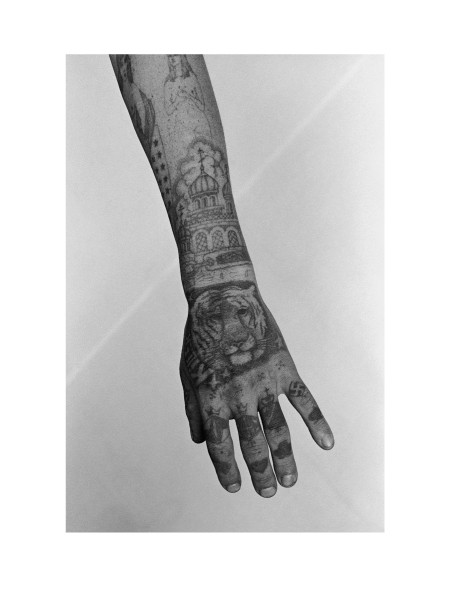
The tiger and the text ‘Killer’ (in English) tattooed on the hand symbolise the bearer's aggression. His ring tattoos signify he is a high-ranking thief and an anarchist, who ‘will never be corrected’. In this colony they make and sell wooden items that are in great demand. He was killed by his fellow inmates for refusing to contribute money to the ‘community kitty’.
Scroll for more
Print No. 22

Women’s tattoos are distinguished by their sentimental nature. Lesbian relationships are common in female prisons; acronyms and phrases declaring undying love are popular. The text at the top reads: ‘If you want to grab grief – fall in with love me!’ and below ‘Let my love lie on your life like a tombstone’.
Scroll for more
Print No. 23
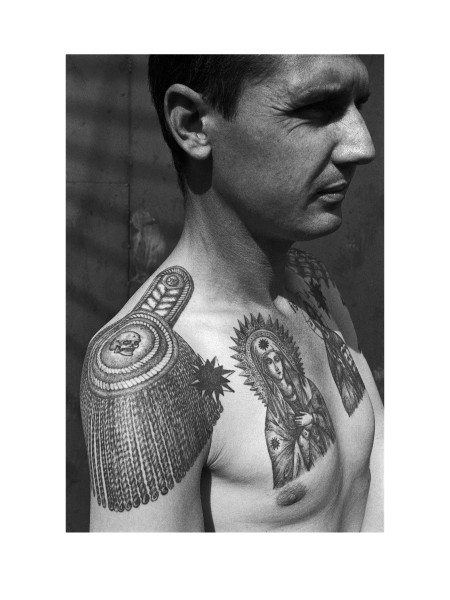
The epaulette tattooed on the shoulder, the thieves’ stars and religious tattoos on the chest all denote this thief’s high rank. The skull in the centre of the epaulette can be deciphered as: ‘I am not and will never be a slave, no one can force me to work’. ‘YK’ indicates the bearer has been through the ‘Intensive Colony’.
Scroll for more
Print No. 24

This photograph was taken in the Special Commandant’s office shortly before the end of the convict’s sentence. The roaring tiger is a symbol of the thief’s aggression, known as an oskal (bared teeth). It is common among convicts who are hostile to the authorities. The text below this tattoo reads ‘Man is wolf to man’. Text under the elbow reads ‘Death to the defeated ones’.
Scroll for more
Print No. 25
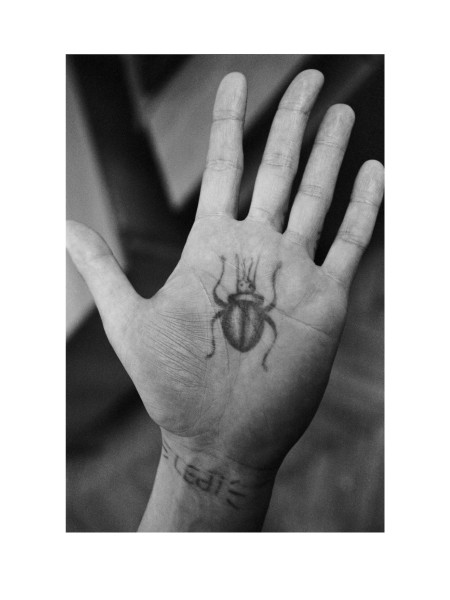
A palm tattoo from a convict detained in this famous prison (constructed in 1890). Beetles, ants, cockroaches, bumblebees, flies, and spiders (without cobwebs) are the symbols of pickpockets. Palm tattoos carrying texts of brief threats and insults (‘Shut up, bitch!’, ‘Beat the party activists!’) were widespread in the late 1940s and mid 1950s.
Scroll for more
Print No. 26
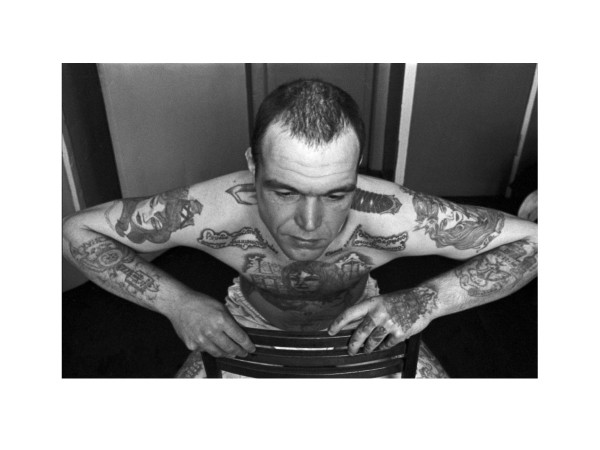
An authoritative, ‘legitimate’ thief. The tattoo on the chest is a portrait tattoo of a loved one, the text in the clouds left and right reads ‘Curse you Communists / for my wasted youth’. Text above reads ‘Give me freedom / I will become more honest’.
Scroll for more
Print No. 27
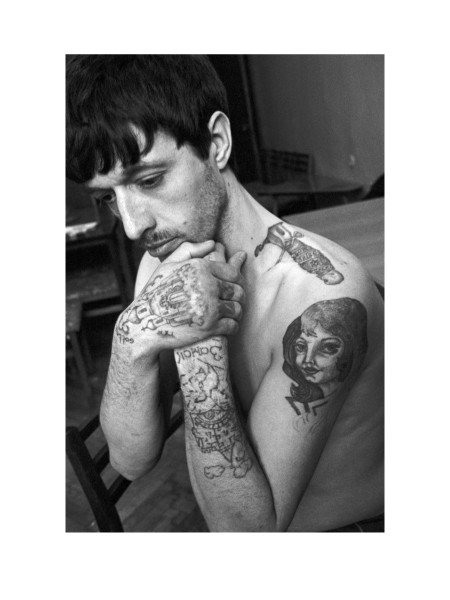
The knife through the neck shows that this criminal committed murder in prison and is available to hire for further murders. The drops of blood can signify the number of murders committed. The Latin text on the handle of the knife reads ‘As long as I breathe, I hope’.
Scroll for more
Print No. 28
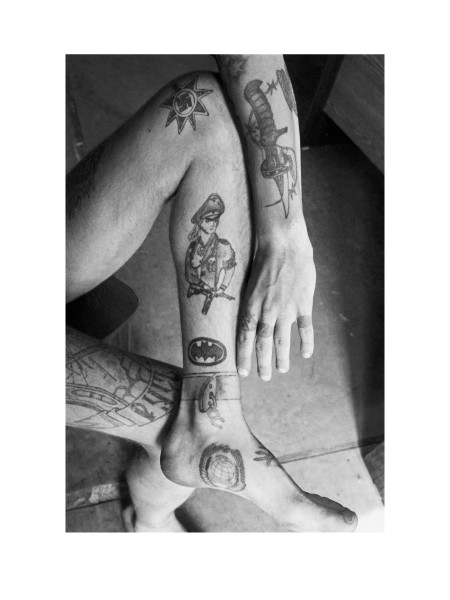
The swastika in the thieves star tattooed on the knee is a symbol of aggression against the authorities. It means the bearer ‘will never be corrected’, and ‘it’s better to be in the SS than the Communist Party’. The fetters on the ankle signify a sentence of five years or longer, if they are broken it means the prisoner was on the run. The dagger through the fetter on the forearm symbolises revenge against the prosecutor.
Scroll for more
Print No. 29
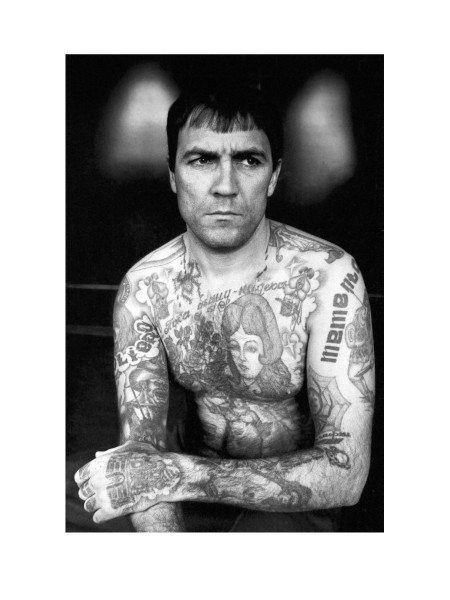
Text across the chest reads ‘As long as I breathe, I hope’. The turbaned man clutching a knife in his mouth indicates an inclination to brutality, sadism, and a negative attitude toward activists – prisoners who openly collaborate with prison authorities (also often a pirate). The Latin text on the shoulder reads ‘Remember your mortality’.
Scroll for more
Print No. 30

German text across the chest reads ‘To each his own’. The SS insignia symbolise agression against the authorities. The Madonna and Child, depicted in the Orthodox tradition of icon painting, means ‘my conscience is clean before my friends’, and ‘I will not betray’.
Scroll for more
Print No. 31
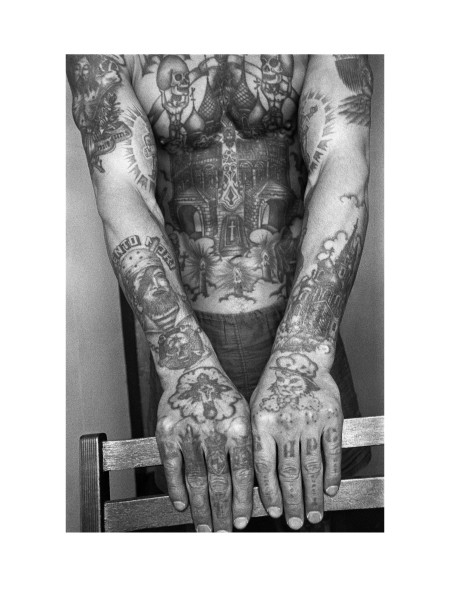
A high-ranking, authoritative thief. In the early 1950s, it became customary for thieves to tattoo dots or small crosses on the knuckles, the number of dots indicating the number of terms. The punishment for the slightest attempt to position oneself as a legitimate or to wear an undeserved tattoo was severe. At best, the tattoo would be removed with sandpaper or a razor, but it was not uncommon for the offender to be raped or killed. Convicts were even punished for tattooing more dots on their hands than sentences they had served, or for wearing a ring tattoo with the symbol of a crime they hadn’t committed. German text on the top of his right arm reads ‘God with us’. Latin text on the forearm ‘Remember your mortality’. Text on the fingers of the left hand reads ‘BARS’: (literally ‘lynx, snow leopard’), Bey Aktiv, Rezh Suk (beat up activists, kill bitches); underneath this ‘No Salvation, No Happiness’.
Scroll for more
Print No. 32
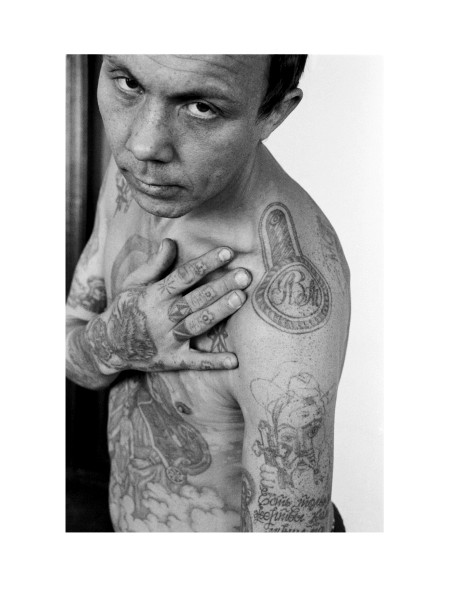
Prison is this thief’s home, he is of the highest rank in the thieves’ social hierarchy. His ring tattoos show that he was the only underage detainee in his circle of thieves, and that he is an ‘anti-social’: an inveterate transgressor of the prison regime, who completely refuses to work. The text on the arm reads ‘Communism only produces victims’.
Scroll for more































